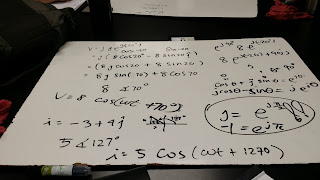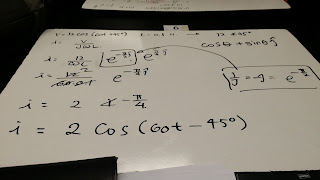Today we went over how to rewrite sinusoids into phasors and exponential.
Practice problem on adding sinusoids
Practice problem on converting exponential to phasor using eulers method
Practice problem on converting rectangular to polar
Practice problem on converting sinusoid to phasor
Practice problem on finding current in different forms
Practice problem on Graphical Representation method of addition
Practice problem on finding out which equation is leading
Practice problem on solving problem that requires some conversion back and forth
"Phasors: Passive RL Circuit Response " Lab
Prelab:
measuring the resistance
Waveform Graph:
at omega=10 omega_c (Blue is V_n, red is I_n)
at omega=omega_c /10 (Blue is V_n, red is I_n)
at omega= omega_c (Blue is V_n, red is I_n)
Summary:
We could see how the voltage leads the current in an RL circuit from the waveform graphs above. We also could see that by adjusting the angular frequency of the signal, we are also changing the phase difference between the current and the voltage in RL circuit. From the experiment conducted, when we increase the angular frequency, the phase difference between the voltage and the current increases, while when we decrease the angular frequency, the phase difference also goes down. The gain has a different trend, where it decreases as angular frequency is increased, and increases as angular frequency is decreases. Both of the trend are in agreement with the formulas that we used/derived.














No comments:
Post a Comment